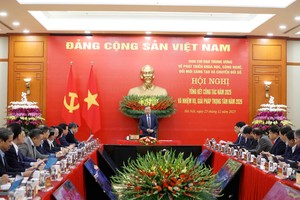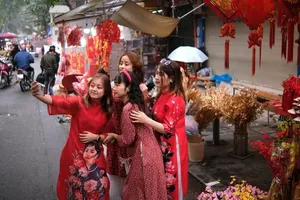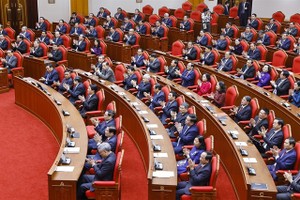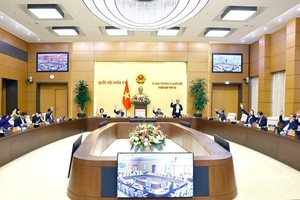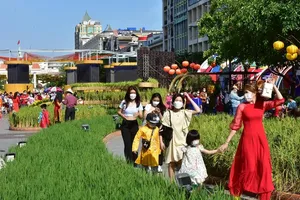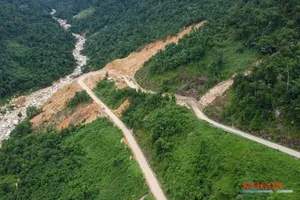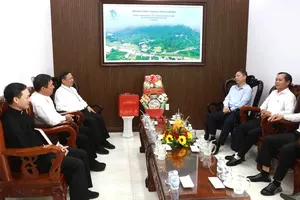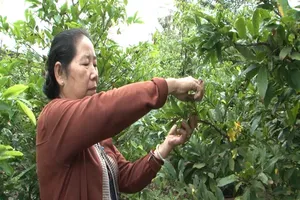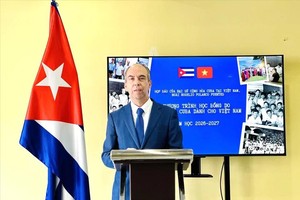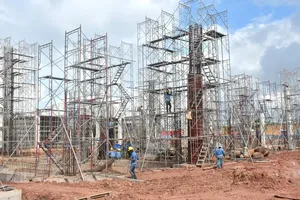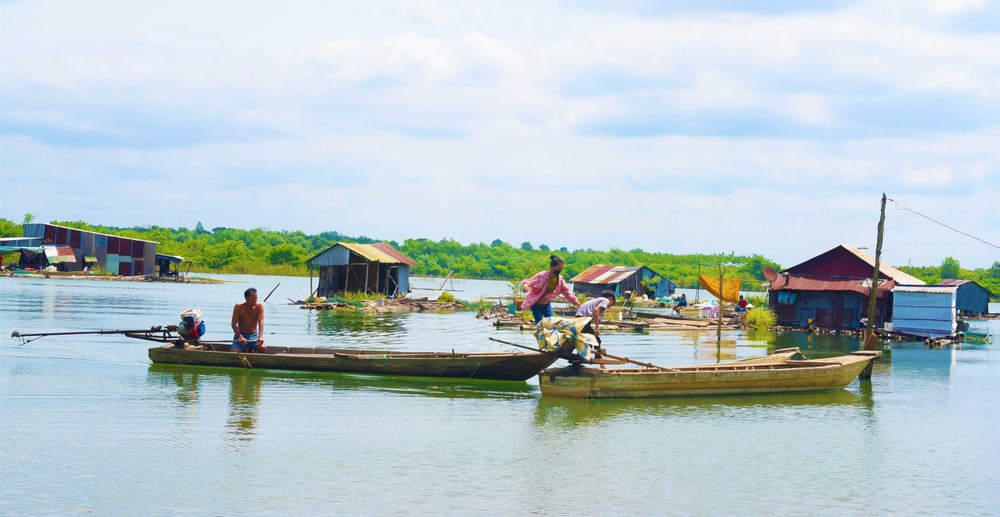
This has helped many households develop aquaculture, fishing, and tourism services, attracting visitors for sightseeing and recreational activities. Along the banks of the Be River in Binh Phuoc and Binh Duong provinces, lush fruit orchards thrive throughout the year, complemented by numerous historical and cultural landmarks that are popular destinations for tourists.
Floating fish farms
Tran Van Khoe's family, 42, residing in Bu Tam Hamlet, Phuoc Minh Commune, Bu Gia Map District, returned from Cambodia to the Can Don Hydropower reservoir in 2008. They built a sturdy wooden house with a tin roof and made a living by raising fish in cages. Khoe shared, "My family raises a few hundred Asian red tail catfish (Hemibagrus wyckioides) in a single cage, harvesting every 2-3 years, earning tens of millions of Vietnamese dong annually. Thanks to the abundant aquatic resources in the reservoir, my wife and I row our boat to cast hooks and nets to catch shrimp and fish to sell to locals, earning around VND200,000-VND300,000 daily."
To supplement their income, the family also peels raw cashew nuts for local processing facilities, earning VND5,000 per kilogram. Though not wealthy, they do not worry about hunger, and their children receive proper education, so Khoe feels secure in staying attached to the reservoir.
Bay Tien Floating Restaurant, located on the Can Don Hydroelectric Reservoir for over a decade, is owned by Phan Thi Cam Thuy and her husband from Phuoc Minh Commune, Bu Gia Map District. Thuy shared that their business, focused on aquatic delicacies like shrimp rolled with rice paper, fish salad, and Asian red tail catfish hotpot, operates smoothly despite its distance from the city center. They acquired the restaurant for VND600 million from a friend. During weekends, holidays, and Tet, the restaurant attracts a bustling crowd seeking dining, leisure, and boating experiences on the reservoir. After expenses, Thuy earns approximately VND50 million monthly.
Mr. Bui Ngoc Thuy, Vice Chairman of the People's Committee of Phuoc Minh Commune, said that the Can Don Hydroelectric Project commenced construction in 2003, resulting in the creation of a large reservoir as water levels rose during damming. Recognizing the reservoir's potential, over a decade ago, approximately 90 households settled here, engaging in farming, aquaculture, and fishing for their livelihoods. Presently, nearly 50 households have been relocated to Hai Can Hamlet, Phu Nghia Commune (Bu Gia Map District), while others who do not yet meet resettlement criteria continue to live around the reservoir to make a living. Importantly, due to their diligence, poverty has been alleviated among these families, children are able to attend school, and local residency regulations are adhered to.
Connecting river tourism routes
From the center of Dong Xoai City (Binh Phuoc Province), we traveled down the DT741 road towards Phu Giao District (Binh Duong Province). From the road, we could already see the unique sight of a broken bridge (Song Be Bridge, Gay Bridge) spanning the Be River.
According to a survey by the Binh Duong Province Heritage Management Board, the bridge is over 4.5 meters wide, with each remaining section about 50 meters long, consisting of three spans of steel and concrete beams. The highest points on both sides of the bridge are 6 meters, the lowest points are 3.5 meters, and the bridge's piers are 30 meters high. Historically, the Song Be Bridge was built by the French between 1925 and 1926, when they established the Phuoc Hoa Rubber Plantation to serve colonial exploitation and expand rubber plantations in the Phu Giao and Phuoc Long areas.
During the resistance war against the Americans, the soldiers and civilians of Phu Giao organized numerous attacks to weaken the enemy. The pinnacle of these efforts was the night of April 27 and the early morning of April 28, 1975, when the armed forces of Phu Giao District defeated the enemy and took control of Binh My and Binh Co communes along Route 16. This action paved the way for two columns of Army Corps 1 to advance West towards Di An and Lai Thieu, forcing the enemy in Phu Giao District (Phuoc Vinh) to retreat across Song Be Bridge and flee towards Lai Khe. During their retreat, the enemy planted mines to destroy the Song Be Bridge to hinder the advance of the liberation forces.
Today, the Gay Bridge - Song Be stands as a historical monument, symbolizing the resilient and heroic revolutionary spirit of the soldiers and people of Binh Duong Province.
Nguyen Minh Hoang, 50, residing in Ho Chi Minh City, along with a group of friends, traveled over 70km to visit the Gay Bridge on the occasion of the 49th anniversary of National Reunification Day (April 30, 1975 - April 30, 2023). He said, "The sight of the Gay Bridge in the middle of the river is unique. Coming here, we experienced the beautiful, pristine natural scenery. People were diving to catch fish, rowing boats on the river, creating a serene atmosphere."
Le Minh Khang, who lives near the bridge, shared, "Many people have come here to take wedding photos. Recently, several film crews have also come to scout for filming locations, and many foreign tourists have come to explore and take pictures, making this rural area much more lively."
The Be River T-junction, bordering Hieu Liem Commune in Bac Tan Uyen District, Binh Duong, and Hieu Liem Commune in Vinh Cuu District, Dong Nai, where the Be River merges with the Dong Nai River, may be unfamiliar to many. However, for the residents of Hieu Liem Commune, it holds cherished childhood memories. Mai Anh, 38, residing in Hieu Liem Commune, was born aboard a boat and grew up intimately familiar with the river. She understands the distinct water flow at the river junction, where the murky water of the Be River merges with the clearer Dong Nai River. She said, "During the rainy season, you can see the two clearly different colors at the river mouth. The vast space at the river junction creates a stunning image, offering great potential for developing river tourism."
To Huu Phuc, 83, who lived and fought in the Be River area, suggests that developing tourism routes in the Vam Song Be area could be a breakthrough, attracting visitors to explore the riverside orchards and offering trips upstream to see landmarks like the Tri An Hydropower Plant and historical sites such as War Zone D. Downstream, they could visit the Gay Bridge and the Phuoc Thanh Provincial Governor's Palace (Phu Giao District). Despite its potential, these ideas are still in the planning stages and have not been fully implemented, so tourism development along the Be River remains relatively modest.
In the development plan for river tourism routes and products in Binh Duong Province by 2025, looking towards 2030, the regions along the downstream basin of the Be River are part of the Eastern development zone, focusing on cultural heritage exploration and eco-tourism. While awaiting effective policy implementation, the region's expansive citrus and fruit orchards, alongside historical landmarks, have the potential to attract both domestic and international tourists through viral videos and widespread media coverage, helping to uplift the quality of life for residents.
